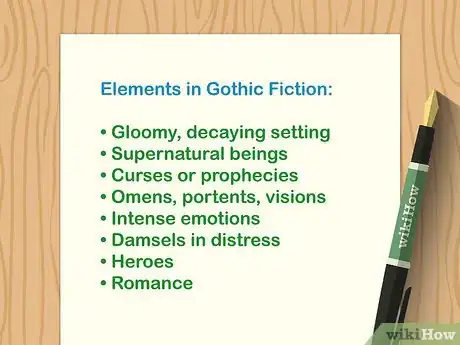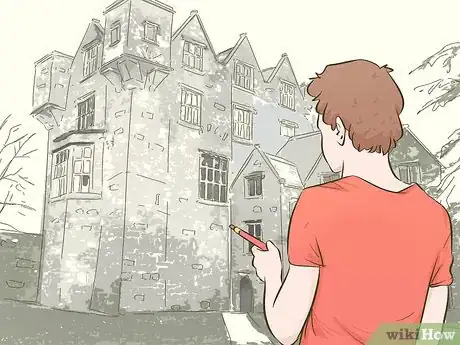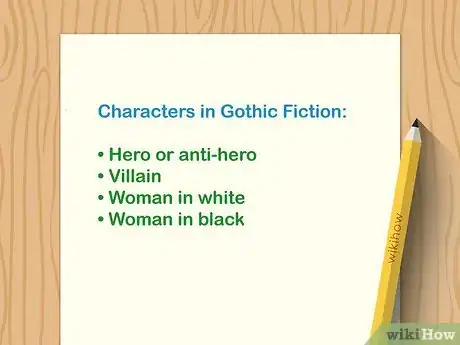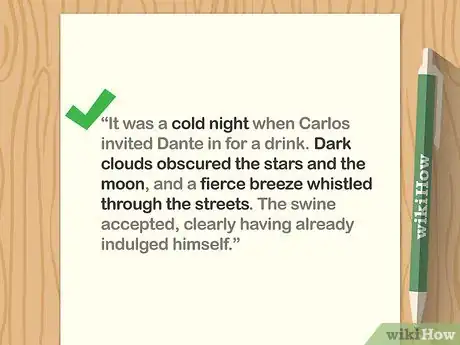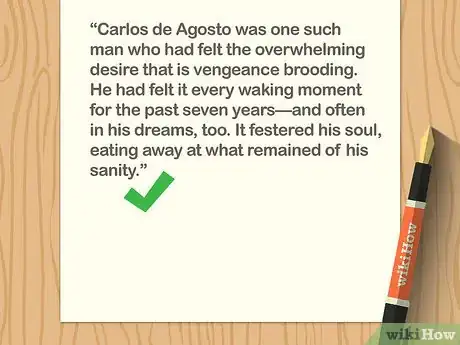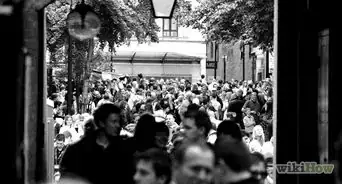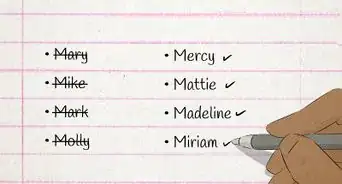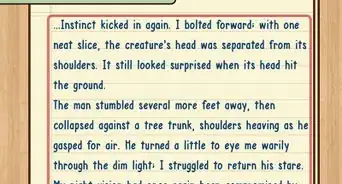This article was co-authored by Christopher Taylor, PhD. Christopher Taylor is an Adjunct Assistant Professor of English at Austin Community College in Texas. He received his PhD in English Literature and Medieval Studies from the University of Texas at Austin in 2014.
There are 9 references cited in this article, which can be found at the bottom of the page.
wikiHow marks an article as reader-approved once it receives enough positive feedback. This article has 21 testimonials from our readers, earning it our reader-approved status.
This article has been viewed 345,548 times.
Gothic fiction is a subgenre of horror, exemplified by authors such as H.P. Lovecraft, Edgar Allan Poe, Mary Shelley, and Wilkie Collins. Gothic horror consists of moody landscapes, supernatural experiences, and an atmosphere filled with dread. You can write your own piece of gothic fiction if you know about its conventions. Keep reading to learn how to write a gothic fiction story.
Steps
Developing Ideas for Your Gothic Fiction
-
1Choose a time when your story will take place. Decide if your story will take place in the past or present. Many gothic fiction stories take place a century or even further in the past.
- A story about the past can make supernatural events and strange characters seem more real to your readers.
- Or, you can write in the present but include lots of elements that hearken back to an older time. Bram Stoker includes modern technology and ancient things in Dracula. He describes typewriters and trains, but he also includes vampires and an ancient castle.
-
2Choose a setting. Settings are important because they help create a creepy atmosphere for your characters. Crumbling buildings, haunted houses, and old castles make great settings for gothic fiction. Your setting should be a place that was once thriving, but has since fallen into decay that feels strange or uncanny to the characters.
- The Overlook Hotel in Stephen King's The Shining is an excellent example of such a location. The Overlook was once a gleaming vibrant vacation spot occupied by many people, but now only Jack and his family occupy it.[1]
- The mood of the environment will influence how the characters act.
Advertisement -
3Create your characters. Your characters are just as important as your setting, so spend plenty of time developing them. Gothic fictions often feature certain types of characters that may help you to develop your own characters.
- Hero or anti-hero. There should be at least one character in your gothic fiction that readers will like, even if he or she has some dark tendencies. Mary Shelley's Victor Frankenstein is a great example of a hero who is good, even though he creates a monster.
- Villain. The villain in gothic fiction stories often plays the role of a tempter, who leads the hero down a dark path. A good villain should be both evil and fun to read about. Dracula in Bram Stoker's Dracula is an excellent example of an interesting, yet evil villain. He does terrible things (like murdering people) and is portrayed by Bram Stoker as the epitome of foreign corruption that threatened Britain's society at the time. Since this fear of invasion was common at the time 'Dracula' was published, it was a very popular Gothic novel.
- Woman in white. Many gothic fiction novels feature a doomed bride or damsel in distress character who never gets her happy ending. Elizabeth from Mary Shelley's Frankenstein is a good example of a woman in white.[2]
- Woman in black. Other gothic fictions include a woman in black character like a widow. Miss Jessel of Turn of the Screw by Henry James is an example of a woman in black.[3]
-
4Develop a plot. Once you have worked out a setting and characters for your gothic fiction story, you will need to figure out what is going to happen to these characters. Like the setting, the plot should show a decline in the hero's world, relationships, and/or sanity. Gothic fictions usually resolve when the hero redeems him or herself with the help of a loved one.
- For example, in Bram Stoker's Dracula Mina redeems herself with the help of her friends.
Making Your Gothic Fiction Unique
-
1Add a supernatural element. Gothic fiction often features something or someone supernatural. Make one of your characters a ghost, vampire, werewolf, or some other supernatural creature. Or, you could use your setting to create an eerie atmosphere that suggests something paranormal is at work. A spooky castle or house can add a supernatural element to your story.
-
2Add children to your story. Children often feature into gothic fiction and they are usually in danger or in the care of less than capable guardians. Having children in your story who are in some sort of danger will infuse your story with extra tension throughout.[4]
- For example, young William Frankenstein wanders off and Frankenstein's monster murders him. [5]
-
3Add a prophecy or curse. Add intrigue to your story by including a prophecy that has something to do with the character or the setting (house, castle, etc.). Prophecies in gothic fiction are usually incomplete and confusing. A good prophecy should cause your readers to scratch their heads and want to know more.[6] Sometimes gothic fiction stories feature a family curse or secret that haunts them. A curse can also help drive your hero's actions and even explain some of his or her behavior. [7]
- For example, a prophecy haunts the family in Horace Walpole's Castle of Otranto. The prophecy says that the castle will pass from Manfred's line. The prophecy seems to have come true when Manfred's son dies.[8]
-
4Add a damsel in distress. Gothic fiction stories often include a young woman who is in danger. This young woman may be your central character or your central character's love interest. You can use this character as a way to influence the emotions of your readers, such as their pity, sadness, and fear. Depict your damsel's reactions to her situation by telling your readers how she feels, acts, and what she says.[9]
- Matilda is in love with one man, but another man lusts after her, which puts her in danger throughout the book.[10]
-
5Consider using a found material or true story framing device. Many gothic novels put forth the story that they tell as true or found in a diary. This way of framing the story adds mystery, since it invites the reader to imagine that the events of the story transpired.
- For example, Mary Shelley and Bram Stoker both use found material framing devices. They present their stories through character letters and journal entries.
Writing Your Gothic Fiction
-
1Introduce your story. At the beginning of your story, take care to describe your setting and characters who are present at the beginning of your story. Just make sure that you don't give away too much information in the beginning. Leave some things to describe later, like the villain and other mysterious elements of your story. You can hint at these things early in your story, but don't give in to the urge to share too much too soon.[11]
-
2Maintain an air of gloom and terror throughout your story. You can make sure that your story has a high level of creepiness by incorporating plenty of unnerving details. Describe the moon, the howling wind, or a dark corridor to maintain an air of gloom and terror throughout your story. You can also describe the way that your characters are feeling or acting, as well as their facial expressions.[12]
-
3Maintain suspense and mystery throughout your story. Tantalize your readers by only offering them quick glimpses of your villain or a ghost. Hint at the family curse but hold off on explaining it until later in the story.[13]
-
4Incorporate descriptions of heightened emotions throughout your story. Describe over-the-top emotions like shrieking, cackling, fainting, and sobbing. These moments of hysteria will pull your readers into the story and help keep them entertained.[14]
-
5Incorporate themes of madness. Describe spooky things from the perspective of a character who has gone mad. This approach will intrigue your readers and lead them to question what is happening.[15]
- For example, Roderick descends into madness in Edgar Allen Poe's “Fall of The House of Usher.” His decline intensifies the story and makes it scarier.
-
6Kill off some of your characters. As much as you might love your characters, good gothic fiction tales usually feature the death of one or more of the main characters. The deaths of your characters do not need to be ultra-gory (although, they can be), but they should be frightening. Use plenty of details to describe the scenery and action of your death scenes.
- For example, a giant helmet crushes Conrad in Horace Walpole's Castle of Otranto. Conrad was on his way to get married.[16]
-
7Conclude with a twist. Good gothic fiction stories often end with a twist that causes readers to wonder about the events and characters of your story. The reappearance of a someone who has died is one way to include a twist, but you can experiment with other types of twists as well.
- Edgar Allen Poe includes twists at the end of his stories that lead readers to question the finality of death. Poe includes one of these twists in “Fall of the House of Usher” when Madeline appears in the doorway and falls on top of Roderick. Roderick had believed that Madeline was dead.
Expert Q&A
Did you know you can get expert answers for this article?
Unlock expert answers by supporting wikiHow
-
QuestionWhat is the Gothic style of writing?
 Christopher Taylor, PhDChristopher Taylor is an Adjunct Assistant Professor of English at Austin Community College in Texas. He received his PhD in English Literature and Medieval Studies from the University of Texas at Austin in 2014.
Christopher Taylor, PhDChristopher Taylor is an Adjunct Assistant Professor of English at Austin Community College in Texas. He received his PhD in English Literature and Medieval Studies from the University of Texas at Austin in 2014.
English Professor
-
QuestionWhat is a Gothic novel in literature?
 Christopher Taylor, PhDChristopher Taylor is an Adjunct Assistant Professor of English at Austin Community College in Texas. He received his PhD in English Literature and Medieval Studies from the University of Texas at Austin in 2014.
Christopher Taylor, PhDChristopher Taylor is an Adjunct Assistant Professor of English at Austin Community College in Texas. He received his PhD in English Literature and Medieval Studies from the University of Texas at Austin in 2014.
English Professor
-
QuestionWhat is Victorian Gothic literature?
 Christopher Taylor, PhDChristopher Taylor is an Adjunct Assistant Professor of English at Austin Community College in Texas. He received his PhD in English Literature and Medieval Studies from the University of Texas at Austin in 2014.
Christopher Taylor, PhDChristopher Taylor is an Adjunct Assistant Professor of English at Austin Community College in Texas. He received his PhD in English Literature and Medieval Studies from the University of Texas at Austin in 2014.
English Professor
References
- ↑ https://www.sgasd.org/cms/lib/PA01001732/Centricity/Domain/553/Frankenstein%20Gothic%20and%20Romantic%20Notes.pdf
- ↑ http://www.theguardian.com/childrens-books-site/2014/oct/28/halloween-top-tips-gothic-writing-chris-priestley
- ↑ http://www.theguardian.com/childrens-books-site/2014/oct/28/halloween-top-tips-gothic-writing-chris-priestley
- ↑ http://www.theguardian.com/childrens-books-site/2014/oct/28/halloween-top-tips-gothic-writing-chris-priestley
- ↑ http://knarf.english.upenn.edu/Chars/william.html
- ↑ https://owlcation.com/humanities/How-to-Write-a-Curse-or-Prophecy-in-Your-Fiction-Writing
- ↑ http://www.theguardian.com/childrens-books-site/2014/oct/28/halloween-top-tips-gothic-writing-chris-priestley
- ↑ http://www.bbc.co.uk/timelines/zyp72hv
- ↑ http://www.virtualsalt.com/gothic.htm
- ↑ http://www.bbc.co.uk/timelines/zyp72hv
- ↑ http://www.writersdigest.com/writing-articles/by-writing-goal/write-first-chapter-get-started/10-ways-to-start-your-story-better
- ↑ http://www.virtualsalt.com/gothic.htm
- ↑ http://www.virtualsalt.com/gothic.htm
- ↑ http://www.virtualsalt.com/gothic.htm
- ↑ https://www.thegothiclibrary.com/gothic-tropes-madness/
- ↑ https://study.com/learn/lesson/the-castle-of-otranto-horace-walpole-summary.html
About This Article
To write a great piece of gothic horror, start by setting your story in a strange, decaying place with a creepy atmosphere, like a crumbling castle or a haunted house. Then, spend plenty of time developing your characters. Create a main character that has some dark tendencies but is still sympathetic, and a villain who tempts the hero towards a dark path. If you need some inspiration, look for examples in the works of the great gothic horror writers, including Bram Stoker, Mary Shelley, and Edgar Allan Poe. For more writing tips from our Literary co-author, like how to develop an engaging plot, keep reading!
